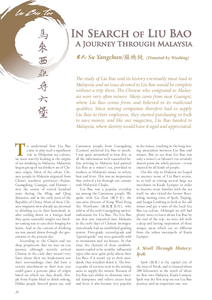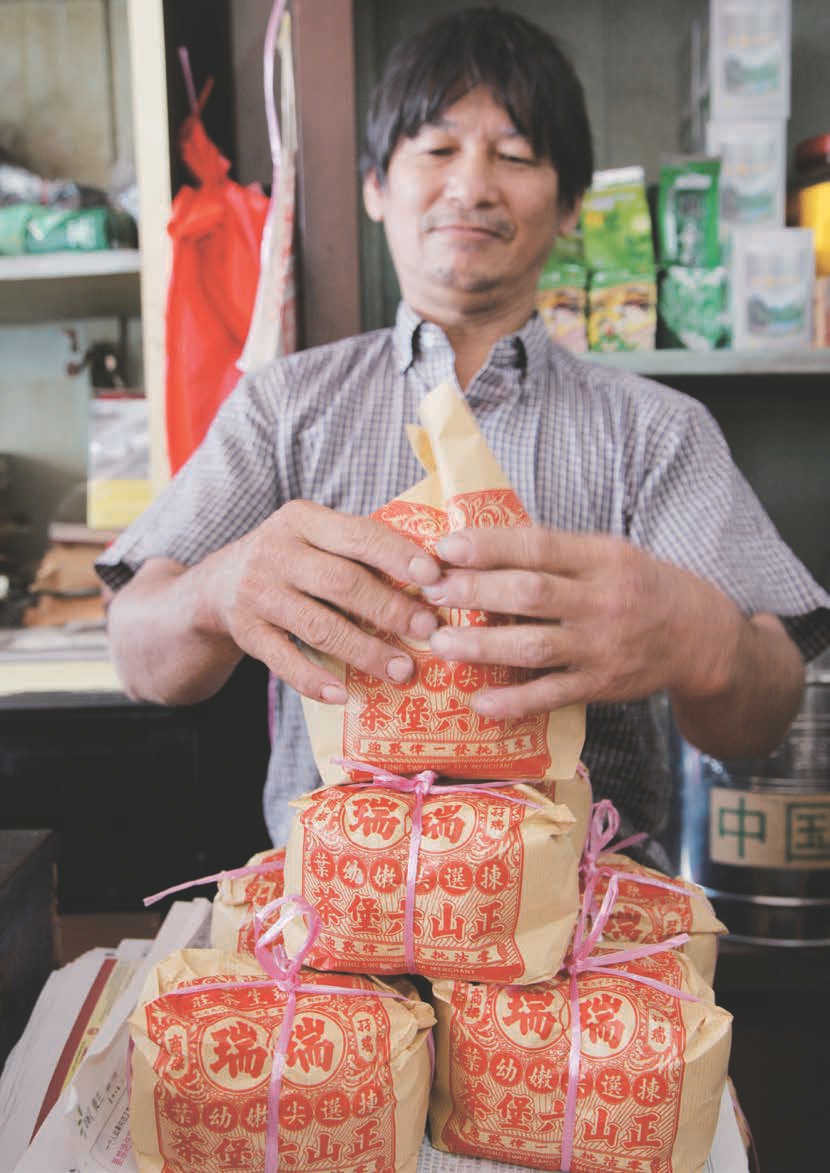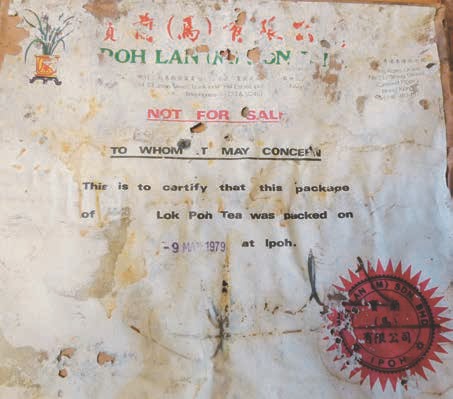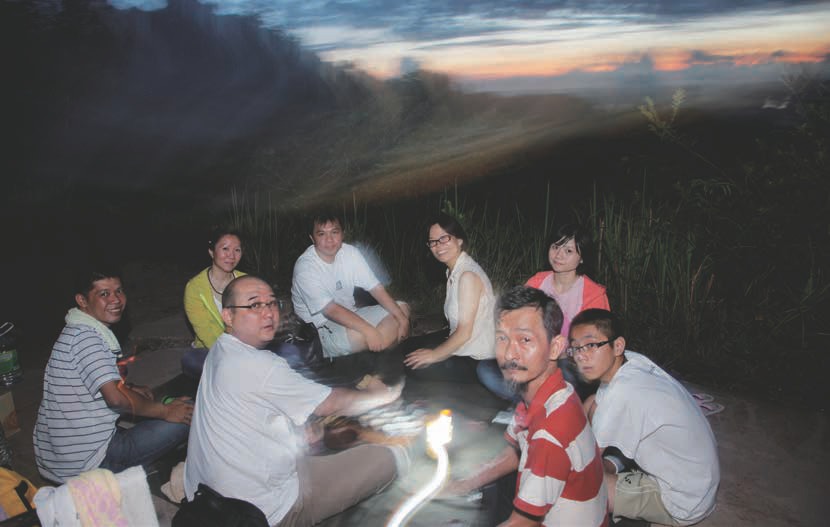
 |
|
To understand how Liu Bao came to play such a significant role in Malaysian tea culture, we must start by looking at the origins of tea drinking in Malaysia. Malaysia's largest group of tea drinkers are of Chinese origin. Most of the ethnic Chinese people in Malaysia migrated from China's southern provinces - Fujian, Guangdong, Guangxi, and Hainan - over the course of several hundred years during the Ming and Qing dynasties, and in the early years of the Republic of China. Most of these Chinese migrants were already accustomed to drinking tea in their homeland, so after settling down in a foreign land they quite naturally sought out familiar-tasting teas to ease their longing for home. And so the custom of drinking tea was passed down through the generations to the present day.
According to the Chajin and tea shop proprietors that we met on our journey, although recently arrived Chinese in the early days weren't very fussy about their tea implements nor their surroundings, they did have a certain attachment to their teas: you could guess a person's place of origin based on which tea they drank. People from Fujian liked to drink oolong, Hakka people favored green tea, and Cantonese people from Guangdong (Canton) preferred Liu Bao or puerh. I was quite astonished to hear this, as all the information we'd researched before arriving in Malaysia had painted Liu Bao as a miner's tea, provided to workers at Malaysia's mines to relieve heat and fever. This was an impression that evolved a lot through our contact with Malaysia's Chajin.
Liu Bao was a popular everyday tea among the Cantonese people. We spoke with Liu Zicai (劉子才), the executive director of Kong Wooi Fong Tea Merchants (廣匯豐茶行), who told us of the early Guangdong natives' enthusiasm for Liu Bao. The Liu Bao tea that was imported into Malaysia in the early days of Chinese immigration already had an established grading system. First-grade, second-grade and "special-grade" teas were generally sold to restaurants and tea houses. At that time, the clientele of these establishments tended to be wealthy, influential types who were quite picky about their Liu Bao: if it wasn't up to their standards, they wouldn't drink it. The lower grades of tea were sent to the mining areas to supply the miners. Because of Liu Bao tea's ability to eliminate internal dampness and relieve excess heat and fever, it also became very popular in the mines, resulting in the long-lasting association between Liu Bao and miners. But to say than Liu Bao was only a miner's or laborer's tea certainly doesn't paint the whole picture - it was enjoyed by all kinds of people.
On this trip to Malaysia we hoped to uncover some of Liu Bao's secrets, so as well as visiting several large tea merchants in Kuala Lumpur in order to become more familiar with the tea itself, we also visited the former flourishing mining cities of Ipoh, Taiping, and Sungai Lembing to look at the old mines and get a taste of the local Liu Bao tea culture. Although we still had plenty more to learn about Liu Bao by the end of the trip, we were left with a deep and lasting impression of these unique areas which are so different from the urban metropolis of Kuala Lumpur.

Ipoh (怡保) is the capital city of the state of Perak, and is situated about 200 kilometers to the north of where we flew into Malaysia, Kuala Lumpur. Ipoh was the first stop on our Liu Bao journey, and an important one, too. The city has a couple of nicknames: it's known as the "Mountain City" because of its mountainous surroundings, and thanks to its many limestone caves and streams, it's also sometimes called "Little Guilin," after the city in China's Guangxi Province famed for its rivers and striking rock formations. Recent years have seen a boom in the region's tourism industry, but further back in the past, before World War II, it was a busy mining town abundant in tin ore. At that time, southern Chinese people were leaving their homeland in great numbers with dreams of making their fortune mining tin, and many of them put down roots in Ipoh. Today, the ethnic makeup of the city's residents is largely Cantonese and Hakka, and Cantonese is the primary language of communication. The prosperity of the mining industry at the time also attracted British colonialists who stationed themselves in Ipoh, so if you take a walk down the streets of the city, you can see old English buildings all over the place which remain from that period. The whole city of Ipoh has a very historical feeling to it.

Strolling through the streets of Ipoh and stopping to peruse the old shops, you notice that Liu Bao seems not to belong exclusively in tea stores; it appears in all sorts of places, from seafood merchants to variety stores and paper puppet studios. The store owners explained that Liu Bao is such an everyday commodity that you can buy it and drink it everywhere; it's not just the purview of tea merchants. We really got the feeling that Liu Bao tea has planted itself into every corner of the local people's lives.
While we were in Ipoh we visited a few old tea merchants; although some of them no longer sell Liu Bao, the rich cultural atmosphere and historical goods that these establishments have to offer are nonetheless fascinating. Strolling through the streets of Ipoh and stopping to peruse the old shops, you notice that Liu Bao seems not to belong exclusively in tea stores; it appears in all sorts of places, from seafood merchants to variety stores and paper puppet studios. The store owners explained that Liu Bao is such an everyday commodity that you can buy it and drink it everywhere; it's not just the purview of tea merchants. We really got the feeling that Liu Bao tea has planted itself into every corner of the local people's lives.


Taiping is one of the oldest towns in Malaysia. It is situated around 100 kilometers to the north of Ipoh. At one time it was the capital of Perak, before being replaced by Ipoh in 1937. Taiping is one of few places in Malaysia with a name of Chinese origin. Its name came about after a period of fighting and unrest between the local population and the early Chinese settlers; after the disputes were finally settled, the town was given its name to express the people's prayers for continued peace in the region - in Chinese, Taiping (太 平) means "peace and tranquility." The town was home to Malaysia's first tin mine and developed earlier than Ipoh. In more recent times, as supplies of tin ore have declined, the area has instead become a well-known holiday spot, earning a growing reputation among tourists who come to enjoy the area's abundant natural resources and beautiful scenery.
Because of the booming mining industry in the early days, Taiping achieved a lot of "firsts" in Malaysia, such as the first train station, the first tin mine, and the first prison. The Taiping Lake was also the first manmade lake. The area where the lake now stands was once an abandoned mining ground that slowly accumulated water and became a lake. In 1980, it was turned into a public garden and planted with many flowers, grasses, and trees. Today, the Taiping Lake Gardens are lush and green, and filled with enchanting scenery.
After soaking up the tranquility of Taiping Lake, we ventured on to the Matang Mangrove Forest Reserve at Kuala Sepetang. In the past, this area was well-known for its charcoal exports, and the charcoal workers, just like the miners, relied on drinking Liu Bao tea to provide relief from the heat of their work. We went to visit one of the still-operating charcoal kilns - the intensely hot, dry atmosphere around the kilns is hard to bear for very long, so it's little wonder the charcoal workers needed to drink a lot of Liu Bao to refresh and rehydrate themselves.

After visiting the first two mines we continued on to another famous subterranean tin mine on Malaysia's east coast: Sungai Lembing (also known by the Chinese name Linming - 林明). Home to what was once the longest and deepest underground tin mine in the world, Sungai Lembing was also governed by the British colonialists in the early days, as evidenced by the many historic English-style buildings in the area. Although the mine has now closed down, it has left a rich cultural and historical legacy in Sungai Lembing. The renowned Sungai Lembing Museum contains many restored tools and historical photographs, offering visitors a detailed view into the tin mining process over the years.
At the introduction of tea expert Mr. Qiu Shunchang (邱順昌), we met one of the miners who used to work in Sungai Lembing: a gentleman of sixty or seventy by the name of Mr. Zeng (曾). We were lucky enough to be guided around the tin mine by Mr. Zeng himself. Outfitted with original mining equipment, he gave us an introduction to the mining process. Standing there at the entrance to the mine, we could feel the cold air coming out of the ground - this all added up to a vivid picture of what it must have been like for the miners working in those underground tunnels, with their feet soaked in freezing water and cold drafts of air blowing past. It must have taken many gulps of strong, rich Liu Bao tea to warm their stomachs and chase away the damp. Mr. Zeng told us that in those days, the owners of the mine would always provide Liu Bao tea - if they didn't, they wouldn't be able to find any miners willing to work for them!
Aside from its famous tin museum, Sungai Lembing is also known today for its beautiful mountain sunrises. Every year, tourists from all around arrive to stay in the village guesthouses and catch a glimpse of the ethereal sea of clouds as the dawn breaks over the mountains. Our tea master, Mr. Qiu, suggested that we combine our appreciation of the local scenery with our quest to learn about tea, and so we headed to the top of the mountain to welcome in the sunrise while tasting some Liu Bao. In the first glimmer of dawn and the fresh morning air, our hearts were full with the beauty of the tea.
On the course of our journey through Malaysia in search of a deeper understanding of Liu Bao, we came across many interesting people and places that were all connected to Liu Bao tea in their own way. It felt like we were drawing away a veil; and yet, this tea, with its long history, still holds many mysteries. There are many more layers of cloth for us to slowly peel away, revealing still more about Liu Bao's flavor and origins. For me, the joyful and poignant moments of our Malaysian journey have added another layer of depth to Liu Bao tea: the indelible flavor of personal memories.

While in Eastern Malaysia. Tea master Lin Ping Xiang (林平祥) and Shunchang Qiu (邱順昌) took us to a mountain along the seashore to watch the sunrise while sipping fantastic Liu Bao tea.
We left at 4am to climb Lembing Mountain in the pitch dark. We arrived at the peak before the crack of dawn to view the sunrise. To our surprise, the masters were very prepared, bringing a full tea set with them. Besides a nice picnic blanket, they had exquisite antique Yixing pots, Ming Dynasty porcelain cups, charcoal, a brazier and, of course, very fine water. They even brought cushions for us all to sit on. These Chajin understand tea! The coals heating clean spring water and the most suitable teaware were the perfect combination, producing a pot of tea that left us savoring the flavor and fragrance for hours. Master Lin said that in gongfu tea, none of the important elements can be compromised, helping the tea to reach its full potential, unfolding all its subtleties. After that day, I'd have to agree!
We tasted sweet YSC Old Label Liu Bao tea to quench our thirst and catch our breath after the long hike up the mountain. Then we picked the stronger Zhong Cha to give us a boost and start the day off right. After that, PL LLLL367 was ready, and the first rays of sun shone exquisitely on the reddish tea liquor. This momentary union of Heaven, Earth, Tea and human beings moved us beyond words! We fell silent... The fourth tea was the "Four Golden Coins (四金錢)" from Shenchang Xuanzhuang (慎昌選 莊). A soft sweetness unfolded alongside the twilight of a beautiful dawn! Then came the grand finale, "Joy to the World" (Pu Tian Gong Qing, 普天共慶, "Diamond Grade Yuandu," 原度), the best Liu Bao there is! The rich aroma spread out from the tip of our tongues like a drop of water rippled across the surface of a pond, just as the morning sun lit up the surroundings and our souls... As we sat on the highest spot in Kuantan, savoring such fantastic Liu Bao tea, the spectacular sunshine brightened the long-forgotten Liu Bao tea culture of Malaysia.
